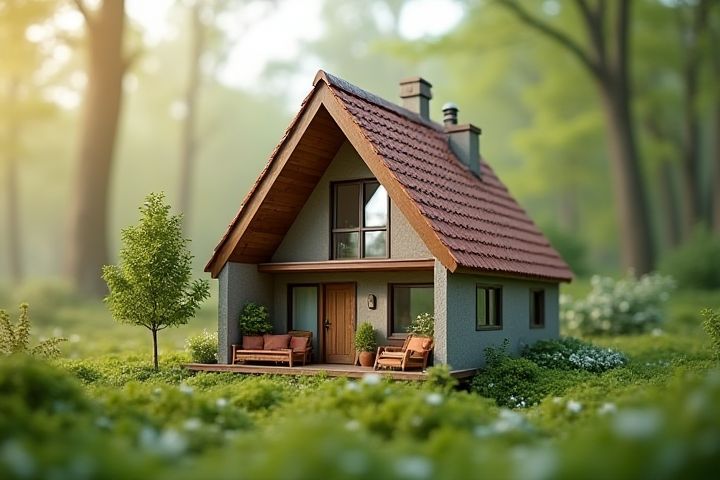
A house can achieve zero carbon status by minimizing its energy consumption and utilizing renewable energy sources. Incorporating energy-efficient appliances, high-quality insulation, and smart home technologies can significantly reduce the overall carbon footprint. Installing solar panels or wind turbines allows homeowners to generate their own clean energy, further decreasing reliance on fossil fuels. Utilizing sustainable materials for construction, such as reclaimed wood or recycled metal, contributes to reducing embodied carbon. Engaging in carbon offset programs through reforestation or sustainable projects can ensure that any remaining emissions are effectively balanced, enabling you to live in a truly zero carbon home.
Can A House Be Zero Carbon
Energy efficiency
A house can achieve zero carbon status by prioritizing energy efficiency measures. Implementing high-performance insulation can reduce heating and cooling demands by up to 50%, while energy-efficient windows can decrease heat loss significantly. Utilizing renewable energy sources like solar panels can offset remaining energy consumption, with a typical system generating between 5,000 to 10,000 kilowatt-hours annually for an average-sized home. Incorporating smart home technology enables optimal energy use, allowing you to monitor consumption trends and automate systems for enhanced efficiency.
Renewable energy sources
A zero carbon house is achievable by integrating renewable energy sources such as solar panels and wind turbines. Solar energy harnessed through photovoltaic cells can significantly reduce dependency on fossil fuels, generating clean electricity for your home. Implementing energy-efficient appliances and systems like geothermal heating can further lower energy consumption, complementing your renewable installations. By utilizing energy storage solutions, such as batteries, you can optimize your energy use, ensuring sustainability and minimal environmental impact.
Insulation quality
Achieving a zero-carbon house heavily relies on high-quality insulation, which significantly reduces energy consumption for heating and cooling. Insulation materials with high R-values, such as spray foam or cellulose, can minimize thermal bridging and air leaks, leading to lower energy bills and a more comfortable living environment. Properly installed insulation in walls, roofs, and floors can result in energy savings of up to 30%, contributing to your home's overall carbon footprint reduction. Prioritizing insulation quality not only maximizes energy efficiency but also enhances indoor air quality by reducing reliance on HVAC systems.
Heat pump systems
A zero-carbon house can effectively utilize heat pump systems to achieve energy efficiency and reduce carbon emissions. Heat pumps can reduce energy consumption by up to 50% compared to conventional heating systems, providing both space heating and cooling. Implementing a high-performance heat pump, combined with renewable energy sources like solar panels, can enable a home to produce as much energy as it consumes annually. Your transition to a zero-carbon home enhances sustainability while potentially saving thousands in energy costs over time.
Solar panels
A zero-carbon house effectively utilizes solar panels to significantly reduce its carbon footprint. Typically, a well-placed solar panel system can generate between 5 to 10 kWh per day per panel, depending on location and weather conditions. By covering most of your energy consumption through solar energy, your household can potentially eliminate over 90% of its greenhouse gas emissions. Investing in energy-efficient appliances and insulation alongside solar technology maximizes energy savings, enabling your home to become a sustainable and eco-friendly space.
Sustainable materials
A house designed to be zero carbon can effectively utilize sustainable materials such as bamboo, reclaimed wood, and recycled metal. These materials not only have a lower environmental impact but also enhance energy efficiency, reducing overall carbon emissions throughout the lifespan of the home. For instance, using straw bales or earthbags for insulation can significantly minimize the need for traditional, resource-intensive materials. By opting for locally sourced and renewable materials, you can further decrease transportation emissions, contributing to a truly sustainable living environment.
Passive house design
A house can achieve zero carbon status through the adoption of Passive House design principles, which emphasize energy efficiency and sustainable construction. This approach typically includes superior insulation, airtightness, and high-performance windows, resulting in a reduction of energy consumption for heating and cooling by up to 90%. Integrating renewable energy sources, such as solar panels, can further offset any remaining carbon emissions, making it feasible to reach net-zero energy levels. To meet Passive House standards, a building must also adhere to specific metrics, such as a maximum annual heating demand of 15 kWh per square meter.
LED lighting
A zero-carbon house can effectively utilize LED lighting, which consumes up to 80% less energy than traditional incandescent bulbs. By integrating approximately 16 LED fixtures, you can light an average-sized room while significantly reducing your energy bills. Additionally, LED lights have a lifespan of 25,000 to 50,000 hours, minimizing waste and the need for frequent replacements. This shift not only lowers carbon emissions but also contributes to a more sustainable living environment, aligning with eco-friendly building practices.
Electric appliances
A zero carbon house incorporates electric appliances that significantly reduce greenhouse gas emissions, such as induction cooktops, energy-efficient refrigerators, and smart thermostats. By utilizing renewable energy sources like solar panels, you can power these appliances sustainably, decreasing your reliance on fossil fuels. Electric heat pumps provide eco-friendly heating and cooling solutions while minimizing energy consumption. Emphasizing the use of these technologies not only enhances energy efficiency but also contributes to a healthier environment and lower utility bills.
Carbon offset programs
A zero-carbon house can be achieved through the integration of carbon offset programs, targeting a neutral carbon footprint over its lifespan. By investing in carbon credits, homeowners can balance emissions by funding renewable energy projects or reforestation initiatives, effectively mitigating the carbon produced in daily living. The average U.S. household emits around 7.5 tons of CO2 annually, making offsetting almost essential for true sustainability. Engaging in localized carbon offset initiatives not only contributes to global environmental goals but can also enhance your property's market value as eco-friendly homes increasingly attract consumers.
